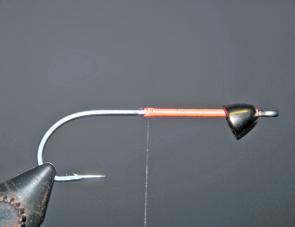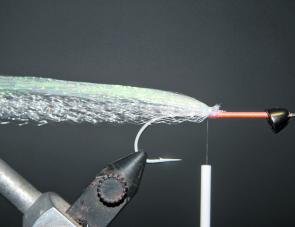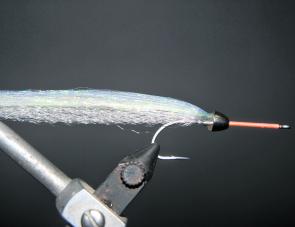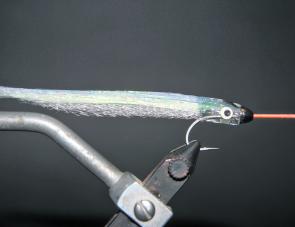As there’s a large amount of baitfish and prey species roaming our waters, naturally there’s a broad array of baitfish patterns to imitate. Garfish are a popular baitfish in saltwater and freshwater environs. There are numerous species of gar, which can range in size from just a few centimetres to well over half a metre.
Gar can be found in the estuarine and offshore environment, therefore including a few garfish imitating patterns in your arsenal is a good ploy. The Candied Gar is a relatively easy pattern, tied from all synthetic materials and is a very hardy and productive fly.
One distinguishing attribute of most garfish species is the beak. On many of these species variations, this beak has an orange hue that makes the garfish unique in its environment and distinguishable. By tying our pattern a little further along the shank, we can produce a fly pattern with a beak very similar in appearance to a garfish.
Additionally, this makes the fly a little more bite proof to predatory species, especially those with sharp teeth, as a good portion of the hook shank is in front of the main body of the fly.
The materials used in the Candied Gar are all synthetic, which makes this fly extremely hardy and a good pattern for the travelling angler as you won’t have any dramas getting it through customs.
The hook I have chosen is a 4X long shanked stainless steel pattern although there is a variety of hooks that can be used. However they would probably need to have at least 3X long shanks to be suitable. The belly is formed with streamer hair. This slightly crimped and translucent material gives the fly some body and helps to support the other materials making up the body and back. It also creates that translucent look to the pattern, which is a feature of most juvenile baitfish species.
For the back I have used DNA Holo Fusion, however Tiewell Ghost Fibre is another option. Both of these materials already have a degree of flash material blended in so no additional flash is required.
I have used a cone head on the Candied Gar to provide some weight and make the pattern sink headfirst when at rest or between strips. The addition of the UV epoxy helps to streamline the pattern and also provides additional weight and durability. The hook shank is wrapped with orange flat-waxed thread to mimic the gar beak although you could paint the shank with nail polish or enamel paint.
Retrieve techniques for the Candied Gar are really no different than that used for most baitfish patterns, although thought has to be given as to your target species and fishing environment.
If you have ever watched garfish cruising around a pier, jetty or rockwall then you would probably have noticed that they move erratically, often with darting movements. This is easy to imitate by using short, sharp strips. Pauses between strips will allow the Candied Gar to sink headfirst. Long, constant and slow strips will also produce a fairly realistic retrieve.
When targeting pelagics such as mackerel, tuna, bonito, queenfish, trevally, tailor and the like, a constant, flat-stick, double-handed retrieve is most likely to solicit strikes.
(1) Pass the hook point through the hole in the cone head and slide it far enough around the hook shank so that you can secure the hook in the vice as normal. Attach the orange flat-wax nylon with a jamb knot approximately half way along the hook shank. Wrap the shank with even wraps of thread right up to the hook eye, ensuring that no bare shank is visible between thread wraps. Whip finish just behind the hook eye and cut away the remaining thread. Slide the cone head forward, right up to the hook eye.
(2) Attach the mono thread at the same point where you initially attached the orange thread. Take a small portion of streamer hair that is approximately three times as long as the hook and tie in at this point with a minimum of wraps.
(3) Take a similar portion of the sage Holo Fusion and tie in directly on top of the streamer hair. Minimise your thread wraps to avoid bulking up this area with thread, as this would prevent the cone head from sliding over it adequately.
(4) Take a portion of iron blue Holo Fusion that is as long as the previous materials but approximately half the volume. Tie this in at this same point with minimal wraps, whip finish, cut away the remaining thread and add a small amount of vinyl cement to the tie.
(5) Push the cone head back hard against this tie in point so that it slips inside the recess in the back. Add some UV epoxy just behind the head to hold in place. Use your UV (black) light to instantly set the UV epoxy.
Five minute epoxy could be used instead of the UV epoxy however the pattern will require rotation while it dries to avoid the glue sagging.
(6) Add an adhesive eye to each side of the fly and then coat with some more UV epoxy and set. Keep adding layers of epoxy until you create a uniform look with the pattern streamlining back from the cone head. Coat the orange thread with a thin layer of vinyl cement to make it more durable. Taper the tail of the fly with your scissors as shown. Your Candied Gar will be a real treat for some predating species.
MATERIALS
| HOOK: | Mustad S74SZ-34011 #2 |
|---|---|
| THREAD 1: | Flat-wax nylon, fluoro orange |
| THREAD 2: | Mono thread, fine |
| HEAD: | Cone Head, nickel 6mm large |
| BELLY: | Streamer hair, white |
| BODY: | DNA Holo Fusion, sage |
| BACK: | DNA Holo Fusion, iron blue |
| EYE: | Self-adhesive 2.5mm glo-in-the-dark |
| FINISH: | Vinyl cement |
| EPOXY: | Loon UV Knot Sense |










